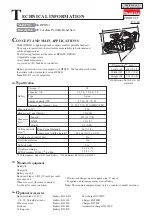
GB
- 350 -
edges. Have damaged cables repaired without delay by a quali-
fi
ed electrician.
3. Keep the battery charger, batteries and the cordless tool out of
children’s reach.
4. Do not use damaged battery chargers.
5. Do not use the supplied battery charger to charge other cordless
tools.
6. In heavy use the battery pack will become warm. Allow the battery
pack to cool to room temperature before commencing with the
charging.
7.
Do not over-charge batteries.
Do not exceed the maximum
charging times. These charging times only apply to discharged
batteries. Frequent insertion of a charged or partly charged batte-
ry pack will result in over-charging and cell damage. Do not leave
batteries in the charger for days on end.
8.
Never use or charge batteries if you suspect that the last
time they were charged was more than 12 months previous-
ly.
There is a high probability that the battery pack has already
su
ff
ered dangerous damage (exhaustive discharge).
9. Charging batteries at a temperature below 10°C will cause chemi-
cal damage to the cell and may cause a
fi
re.
10. Do not use batteries which have heated during the charging pro-
cess, as the battery cells may have su
ff
ered dangerous damage.
11. Do not use batteries which have su
ff
ered curvature or deformation
during the charging process or which show other non-typical sym-
ptoms (gassing, hissing, cracking,…)
12. Never fully discharge the battery pack (recommended depth of di-
scharge max. 80%) A complete discharge of the battery pack will
lead to premature ageing of the battery cells.
13. Never charge the batteries unsupervised.
Protection from environmental in
fl
uences
1. Wear suitable work clothes. Wear safety goggles.
2.
Protect your cordless tool and the battery charger from
Anl_PE_AHE_18_Li_Basic_SPK7.indb 350
Anl_PE_AHE_18_Li_Basic_SPK7.indb 350
15.01.16 13:09
15.01.16 13:09
















































